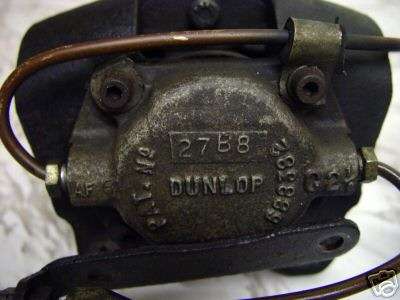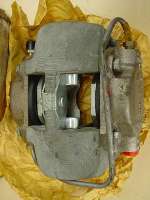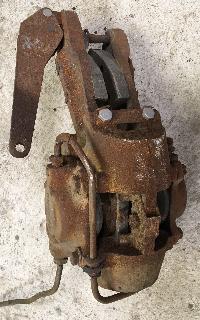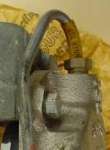The MGA With An Attitude
Fractured BRIDGE PIPES on Brake Calipers - TC-203
 One nagging safety problem pops up occasionally involving the Twin Cam brake calipers. The small hydraulic pipe connecting the left and right halves of each caliper is called the Bridge Pipe. This pipe may suffer a fracture crack near one of the end fittings if not properly installed. Perhaps the most often reported case is the 1959 Sebring race Twin Cam car which had to retire from the race due to a fractured bridge pipe. There have been other reported cases, including some in more recent times. Best analysis of this generally attributes the problem to shock and vibration.
One nagging safety problem pops up occasionally involving the Twin Cam brake calipers. The small hydraulic pipe connecting the left and right halves of each caliper is called the Bridge Pipe. This pipe may suffer a fracture crack near one of the end fittings if not properly installed. Perhaps the most often reported case is the 1959 Sebring race Twin Cam car which had to retire from the race due to a fractured bridge pipe. There have been other reported cases, including some in more recent times. Best analysis of this generally attributes the problem to shock and vibration.

The picture here shows a "P" clip used to secure the bridge pipe to the caliper. The clip has a rubber sleeve to reduce chaffing and corrosion and to assist in vibration damping. When positioned near the middle of the pipe run as shown here the clip will not only dampen vibration but will strictly limit the possible range of motion of the pipe if it does vibrate. Original factory design did not include this clip, but it is common to install one and is highly recommended.
The bad feature in the picture above is the use of copper tubing. Many racing organizations strictly prohibit the use of copper tubing for brake lines, and with good reason. Copper will work harden and become brittle to promote cracks when it flexes continuously (vibration), and it does not have to be deformed to the yield point to incur work hardening. Additionally this pipe is improperly formed. It is bent immediately at the end fittings, having the appearance that the fitting was installed in the caliper first, with the tube being bent afterward. This bend right at the end fitting can cause a sharp kink in the tube which will also create a stress riser point, more likely to promote a crack.

This picture shows a steel bridge pipe properly formed with a short section of straight pipe immediately behind the end fittings such that the fitting can slip up the pipe a bit to assist assembly. The arrow is pointing at a thin plastic sleeve. The mystery about the purpose of this sleeve has been solved. See picture and the Jaguar service bullitin noted at bottom of page.
This is serious business when your life depends on avoiding failure. It is not sufficient to limit "Mean Time Between Failure" to one crack in 100,000 miles of street driving or 100 hours of track time (maybe up to 10,000 miles of serious abuse). For safety sake you have to cut the bridge pipe failures to ZERO, or at least to such a small rate as to be virtually undetectable with 1000 cars over a 10 year period. That may equate to one failure in a 100,000,000 miles of street driving, or 100,000 miles in competition. With appropriate consideration it can be done. Please use steel brake pipe and install the intermediate support clip as shown above.
Some Additional Notes:
At 12:07 AM 11/22/04 +0000, Tony Simms wrote:
>"With regards to the bridge pipes. Have never seen a failure on the street, but I have personally seen 2 failures of rear pipes in racing....once in 1959, once in Vintage in 1992 on John Magills car....and then there is the well documented rear pipe failures in 1960 at Sebring on the works cars.
>
>On the Twin Cam I raced in the early 60s, I added a clip to the rear bridge pipes, held in place by a Piston/Cylinder mounting bolt....it seemed to stop the vibrations that fractured the pipes...no problems in 4 years of racing. On my Vintage cars I removed the steel bridge pipes and replaced them with Earls braided hose....overkill probably, but it certainly works. Bottom line, IMHO, if you are racing or running the high speed rallies, there is a problem with the stock setup, but you should both fix it and also go to Dual Master cylinders....for street use, I would personally retain the steel pipes, but add a clip to each rear pipe."
At 10:06 PM 11/30/04 +0200, Bo Giersing wrote:
>".... YM2 554, the 'Black Mamba' race car ....[and] Bob Olthoff's YDH5 929 .... race the 6 hour at Roy Hesketh circuit on 28th March 1959. .... the original race report back to Abingdon on the preparation and performance of the Twin Cams in this race, quote:"
"At the end of 3 hours the Bundy pipe connecting the calipers of the right rear disc brake fractured immediately under the head of the flare."
>".... The fracture must have been due to a resonant vibration linked to the rigid rear axle setup. Resonant vibration is very difficult to predict .... Abingdon knew about this problem as early as March 1959, .... later bridge pipes were fitted with a short plastic sleeve, possibly to serve as a damper? .... As a precaution, I would fit plastic or rubber sleeves (or some sort of restraint) to the rear bridge pipes."
At 11:36 PM 12/1/04 +0000, Tony wrote:
>"The failures on the Ferguson Motors car at Harewood (Leavens, 1959), John Magills car at Mosport in 1985, and the 1960 works Sebring cars all involved cars with limited slips installed....it looks like vibration causes the failures, but axle "tramp" is not really an issue at racing speeds with the limited slip. My thought is that adding clips to stabilize the rear pipes is a prudent move, as is replacing rear bridge pipes if their history is unknown."
At 01:38 AM 12/2/04 -0500, Jim Alcorn (autovintat icloud.com) wrote:
>"Autovintagery has a good supply of pre-formed brake cross-over pipes @$22.00 each or $80.00 per set of four including vibration clips. These are cad plated steel per original.... note each of the four pipes is a different shape."
At 09:56 PM 1/16/05 -0500, Jonathan Stein wrote:
>"Classic Tube in upstate NY makes Twin Cam Brake lines--the hard ones. A few of us have used them."
> Classic Tube, 80 Rotech Drive, Lancaster, NY 14086
> 800-882-3711 -- 716-759-1800 -- Fax: 716-759-1014
 Addendum December 2006:
Addendum December 2006:
The early Service Parts List shows the front and rear bridge pipes on one side to be the same part number. The front pipes were lengthened at car "#836 approx" according to the third addition AKD1296 Service Parts List. Attempting to fit the shorter rear pipe to the front caliper is a bit of a pain as it is next to impossible to start the threads properly, so making the front ones longer seems to have been a good idea.
This note from the workshop manual bears repeating:
Workshop Manual. Section: Assembling a brake unit.
".... and fit the bridge pipe, ensuring that it is correctly positioned (with the near vertical part of the pipe furthest from the wheel).
Even though this is in the Workshop Manual it is often overlooked. It is critical safety information. Jaguar even put out a Service Bulletin for the XK150S because of the danger, with people not reading the Manual carefully. The Jaguar Service Bulletin says:



 SB 239 - Feb 58:
SB 239 - Feb 58:
Brakes:
Caliper bridge pipe:
Warning on refitting the pipe correctly to avoid fouling the road wheel.
SB 249 - Jul 58:
Brakes:
Caliper bridge pipe:
Now fitted with an ID tag "Inner Top". See SB 239.
This apparently explains the origin of the plastic sleeve on the pipe near the top fitting, bearing the label "INNER TOP". Click for larger picture.

Addendum April 19, 2019:
Here is a picture showing a modern P-clip with rubber bushing installed in the proper location.
Photo compliments of Andrew "Andy" Hinton-Lever in Wilmslow, Cheshire, UK
|
 One nagging safety problem pops up occasionally involving the Twin Cam brake calipers. The small hydraulic pipe connecting the left and right halves of each caliper is called the Bridge Pipe. This pipe may suffer a fracture crack near one of the end fittings if not properly installed. Perhaps the most often reported case is the 1959 Sebring race Twin Cam car which had to retire from the race due to a fractured bridge pipe. There have been other reported cases, including some in more recent times. Best analysis of this generally attributes the problem to shock and vibration.
One nagging safety problem pops up occasionally involving the Twin Cam brake calipers. The small hydraulic pipe connecting the left and right halves of each caliper is called the Bridge Pipe. This pipe may suffer a fracture crack near one of the end fittings if not properly installed. Perhaps the most often reported case is the 1959 Sebring race Twin Cam car which had to retire from the race due to a fractured bridge pipe. There have been other reported cases, including some in more recent times. Best analysis of this generally attributes the problem to shock and vibration. 




